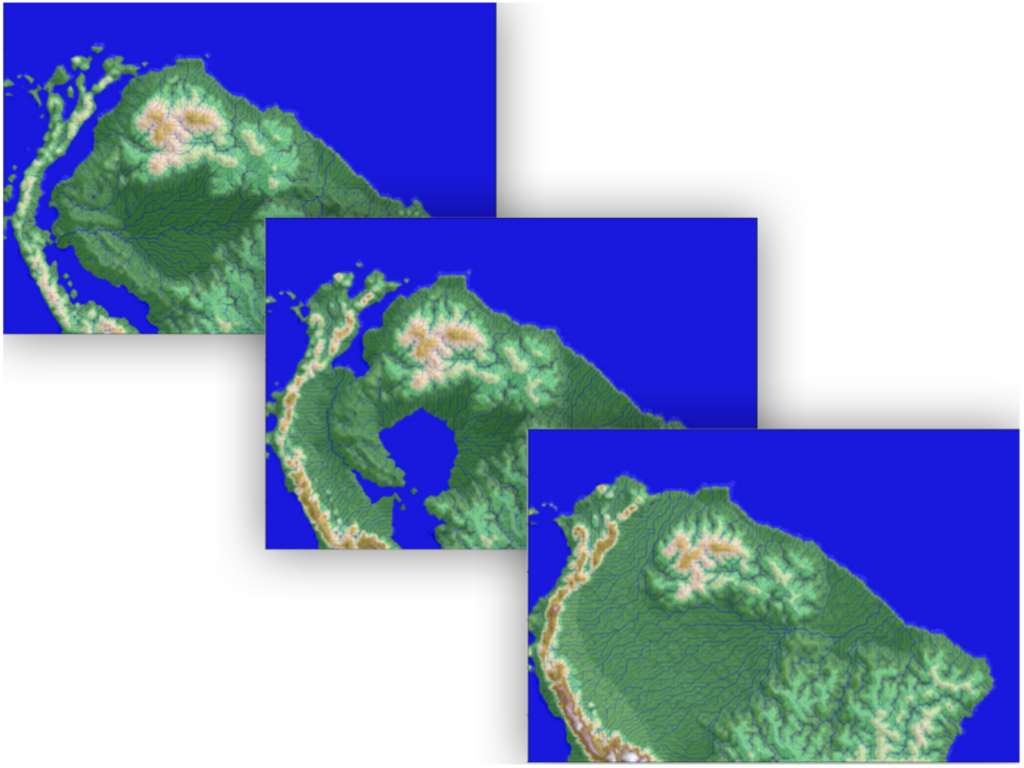
Geodynamic models and landscape evolution models are becoming important tools to quantify the formation and development of paleogeographic features, contributing to our understanding of the patterns of biodiversity evolution.

Victor Sacek is Associate Professor in the Department of Geophysics at University of São Paulo. Conducts research in mantle geodynamics, lithospheric rheology, and the interaction between surface processes and tectonics on continental margins.
Earth, a dynamic system
The Earth’s surface works as a dynamic system and is continuously sculpted through the geological timescale by weathering, wind, rivers, and many other surface processes. Additionally, the dynamics of the Earth’s interior, which includes the crust and mantle, modify the landscape by tectonic processes, for example producing the uplift of cordilleras, inducing the subsidence of sedimentary basins, generating volcanism, and creating new continental margins.
One interesting example of how the coupling of the surface processes with the Earth’s interior dynamics shaped the landscape of our planet is the northern portion of South America, which includes the Amazon drainage basin, the Andes, and the surrounding continental margins. This region underwent different tectonic processes and important features of the landscape were created since the Cretaceous (~145 Ma), from the opening of the Atlantic margin to the formation of the Andean Cordillera. As a consequence, the shape of the present drainage pattern in northern South America reflects this dynamical interaction between the surface processes and the interior dynamics of the planet. Different geological data (Hoorn et al., 2010) indicate that the paleoenvironment in Amazonia changed expressively since the onset of the Andean uplift, resulting in the present transcontinental Amazon drainage basin, which drains water and sediments from the Andes toward the Brazilian Equatorial Margin.
Mantle and mountains
The rate of change of the landscape in Amazonia and the mechanisms involved in its evolution are a matter of debate in the academic community, bringing geoscientists and biologists into heated discussions. In the last decades, different models were proposed to explain how the present Amazon drainage system developed, invoking different geodynamic processes. But, with few exceptions, these models were essentially qualitative, without a physical basis to verify their viability.
An important contribution to the physical understanding of the Cenozoic evolution in Amazonia came from geodynamic models. Based on numerical scenarios of mantle convection, Shephard et al. (2010) simulated the subduction of the Nazca Plate under the western margin of South America and quantified its influence on the landscape evolution of Amazonia. The numerical results indicated the transient development of a regional depression in Western Amazonia, coinciding with the Miocene aquatic environment (between 22 and 14 Ma) known by the geosciences community as the Pebas System. This work showed how mantle convection and its interaction with the lithosphere can induce a profound influence on Amazonia.
Additionally, the development of numerical landscape evolution models allowed the simulation and reproduction of the reshaping of the river networks in northern South America during the rising of the Andean Cordillera (Sacek, 2014). This involves integrating surface processes like erosion and sedimentation, and considering the natural balance within the Earth’s outer shell, known as the lithospheric plate. This model was able to simulate the temporal evolution of the drainage system in northern South America, showing the transition from an axial drainage system parallel to the Andes towards a radial drainage system similar to the present transcontinental Amazon River. In this model, the influx of sediments derived mainly from the Andes toward the Amazon Drainage basin was essential to induce the change of the drainage direction during the Miocene, reproducing the sedimentation rate observed in the interior and marginal sedimentary basins in northern South America.

Snapshots of the numerical scenario from Bicudo et al. (2019) at 27, 17 and 3 Ma. The dimensions of the domain are 5450 km x 3500 km, representing the northern portion of South America, with the Andean Cordillera on the left side.
Mollusks … and more!
These computational models indicate how mantle convection and Andean uplift probably affected the Amazonian landscape evolution. These numerical results contributed to the physical understanding of the geological evolution of Amazonia, filling the gaps from the limited stratigraphic data available, both spatially and temporally. Now, the natural question is: what are the implications of these geodynamic models to the evolution of the most biodiverse biome on Earth?
The first example of geodynamic implication on the Amazonian biodiversity is the development of endemic species of freshwater mollusks. These invertebrates thrived and diversified in the Pebas System during the Miocene (Wesselingh and Salo, 2006) and abruptly disappeared from the fossil record with the end of the lacustrine environment, ultimately controlled by mantle convection (Shephard et al., 2010; Sacek et al., 2023).
After the end of the Pebas System, the transition to a dominantly fluvial environment coincides with the increase diversification of terrestrial species (e.g. Hoorn et al., 2010). Based on landscape evolution models, Bicudo et al. (2019) showed how the influence of the Andean uplift induced the increase influx of sediments and nutrients to the Amazonian plain, indicating the expansion of the várzea and terra firme forests with a dynamic reconfiguration of a mosaic of habitats in the lowlands, probably contributing to amplify the diversification of species during the last millions of years in Amazonia.
The integration of different geodynamic/landscape models with the biodiversity evolution is an exciting subject and it is starting to be explored by sophisticated numerical models. One example is Landlab (landlab.github.io), a flexible open-source package for numerical modeling of the Earth’s surface dynamics that presents new features (SpeciesEvolver) to simulate the evolution of the landscape concomitantly with the biodiversity. Another interesting recent code is AdaScape 1.0 (Acevedo-Trejos et al., 2023), a numerical tool to study the concomitant evolution of tectonics, climate, and biodiversity. New landscape evolution models on spherical adaptive meshes (Salles et al., 2023) open the possibility to study biodiversity evolution on a global scale, with species dispersion on a dynamic terrane, taking into account continental drift. Additionally, sophisticated mechanistic models (Rangel et al. 2018, Hagen, 2023) that simulate biodiversity evolution under different environmental pressures (e.g. climate and elevation) have been developed in recent years. This is just the beginning of a fascinating field.
References: [1] Acevedo-Trejos, E., Braun, J., Kravitz, K., Raharinirina, N. A., & Bovy, B. (2023). AdaScape 1.0: a coupled modelling tool to investigate the links between tectonics, climate, and biodiversity. Geoscientific Model Development Discussions, 2023, 1-25. https://doi.org/10.5194/gmd-2023-72 [2] Bicudo, T. C., Sacek, V., de Almeida, R. P., Bates, J. M., & Ribas, C. C. (2019). Andean tectonics and mantle dynamics as a pervasive influence on Amazonian ecosystem. Scientific reports, 9(1), 16879. https://doi.org/10.1038/s41598-019-53465-y [3] Hagen, O. (2023). Coupling eco‐evolutionary mechanisms with deep‐time environmental dynamics to understand biodiversity patterns. Ecography, 2023(4), e06132. https://doi.org/10.1111/ecog.06132 [4] Hoorn, C., Wesselingh, F. P., ter Steege, H., Bermudez, M. A., Mora, A., Sevink, J., ... & Antonelli, A. (2010). Amazonia through time: Andean uplift, climate change, landscape evolution, and biodiversity. Science, 330(6006), 927-931. https://doi.org/10.1126/science.1194585 [5] Rangel, T. F., Edwards, N. R., Holden, P. B., Diniz-Filho, J. A. F., Gosling, W. D., Coelho, M. T. P., ... & Colwell, R. K. (2018). Modeling the ecology and evolution of biodiversity: Biogeographical cradles, museums, and graves. Science, 361(6399), eaar5452. https://doi.org/10.1126/science.aar5452 [6] Sacek, V. (2014). Drainage reversal of the Amazon River due to the coupling of surface and lithospheric processes. Earth and Planetary Science Letters, 401, 301-312. https://doi.org/10.1016/j.epsl.2014.06.022 [7] Sacek, V., Mutz, S. G., Bicudo, T. C., de Almeida, R. P., & Ehlers, T. A. (2023). The Amazon paleoenvironment resulted from geodynamic, climate, and sea-level interactions. Earth and Planetary Science Letters, 605, 118033. https://doi.org/10.1016/j.epsl.2023.118033 [8] Salles, T., Husson, L., Rey, P., Mallard, C., Zahirovic, S., Boggiani, B. H., ... & Arnould, M. (2023). Hundred million years of landscape dynamics from catchment to global scale. Science, 379(6635), 918-923. https://doi.org/10.1126/science.add2541 [9] Shephard, G. E., Müller, R. D., Liu, L., & Gurnis, M. (2010). Miocene drainage reversal of the Amazon River driven by plate–mantle interaction. Nature Geoscience, 3(12), 870-875. https://doi.org/10.1038/ngeo1017 [10] Wesselingh, F. P., Salo, J. A., (2006). A Miocene perspective on the evolution of the Amazonian biota. Scr. Geol. 133, 439–458.




